by Joanne and Emmett Eldred
(click on photos to enlarge image)
COLLECTING SILVER TEAPOTS AND STANDS
OUR COLLECTING GUIDELINES (5)
The following is the fifth in a series of papers, which
discuss several of the criteria we use in evaluating pieces we
collect. These discussions will highlight our approach when
considering form, originality of teapot and stand combinations,
engraving, hallmarks, condition, and crests & coats-of-arms. In
most cases we have used pictures from our modest but growing
collection to illustrate what is being described.
As is the case with collecting almost anything, the initial
learning curve can be quite steep. Being fairly new to the
subject it certainly applied to us. Our initial screen involved
only two basic areas; form and hallmarks. Our assessment of form
was subjective and based solely on our personal tastes at the
time. Of course having seen only a few examples we did not have
a broad reference base and therefore were unaware of the variety
of designs produced during the later part of the 18th century.
Our second screen was centered on hallmarks. As noted earlier,
one advantage in collecting English silver is its hallmarking
system. Fortunately we were able to locate several excellent
Websites for researching hallmarks, especially maker's marks.
Looking back on things we were very lucky with the majority of
our early purchases. We could have made some costly mistakes
because we did not realize that several other key factors, such
as crispness of the engraving, absence of repairs, surface
patina, presence of an identifiable coat-of-arms or crest, etc.,
significantly contributed to the desirability and therefore the
value of a set.
Over time we became more knowledgeable and ultimately developed
a pretty rigorous set of criteria for evaluating pieces we were
interested in purchasing. Our approach currently involves a
number of assessments (form, originality, engraving, hallmarks,
condition, crest), which we will describe over a series of
articles.
Part 5: CONDITION
Condition is a very important factor
for us. For example the hallmarks should be clearly defined,
leaving no doubt as to what they are, and as we have already
mentioned, the condition of the engraving should be 7 or better.
However it is important to remember that teapots and stands were
meant to be used and therefore should show some signs of age.
Minor scratches and slight dings are likely to be expected and
attest to the set's every day use. Typically major damage to the
teapot can take several forms, which include major dents or
scratches to the body and/or spout. While unattractive this type
of damage does not directly alter a piece’s authenticity. Often
a professional can correct this type of damage, especially if
does not involve a crease or significantly intrudes into the
engraving.
Unfortunately some individuals had a problem with their silver
having someone else’s initials, monogram, or family crest/coat-of-arms.
Therefore they often had someone remove them. In some cases this
can significantly thin or weaken the silver at that point, which
is something that is virtually impossible to fix. This is one
alteration that significantly dampens our desire to purchase a
piece. As mentioned above we feel the addition of an initial,
monogram, or especially a crest and/or coat-of-arms helps
complete the overall statement of the piece. In many cases the
cartouches have always been vacant, and so be it. However we
feel removing of these personalizing engravings alters the
piece’s overall statement. Therefore, for us any piece with
engraving removals has to have some unique merit to warrant
consideration (many collectors do not feel as strongly as we do,
but we felt it important to note our particular bias).
Actual repairs can be more troubling. One of the more common
repairs involves teapot bottoms and is indicated by the presence
of noticeable solder. This was likely done to repair a slight
leak and usually the excess solder can be observed on either the
inside or outside of the bottom. Silversmiths of this period
were highly skilled and solder joins were very neat and hardly
noticeable (as a side note this was not always the case, for
example Hester Bateman pieces tend to be a little “sloppy” in
this regard). However, most repairer’s seem to ascribe to the
philosophy “if it’s not seen, it needn’t be cleaned”. Therefore,
observing globs of silver solder either along the inside and/or
outside bottom edges is a fairly sure indicator of a later
repair. While this distracts somewhat from a piece’s value it
does not significantly impact its originality (unless the repair
is extensive or very poorly executed).
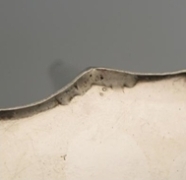 |
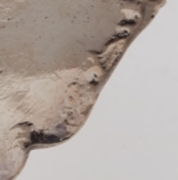 |
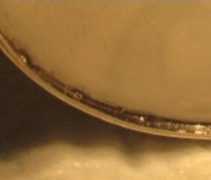 |
Minor repair to a teapot
bottom
|
Major repair to a teapot
bottom
|
Original solder "beads";
Hester Bateman teapot
|
Other fairly common repairs involved
strengthening teapot spouts and handle brackets, or reinforcing
or reattaching feet on teapot stands. Again, these repairs can
usually be detected by the presence of noticeable solder. When
these components were originally attached, the silversmith
heated the silver hot enough for the solder to evenly flow
between the two pieces of silver being joined. Therefore there
was little build up of solder around the joint seam. When a
repairer added new solder to strengthen a joint the solder
typically did not flow under the two pieces of silver as was the
case originally. Rather the solder layered on top of the seam. A
skilled repairer would then have to spend a fair amount of time
detailing the repair by filing off the excess solder. Most
repairers spent relatively little time "fine-tuning" their
repairs, so reinforced or repaired joints usually appear
somewhat crude when compared to other original joints on a
piece. Another clear indication of a later repair is the
presence of small voids or depressions along the seam. These
were formed when escaping gas formed small bubbles as the solder
cooled.
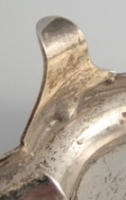 |
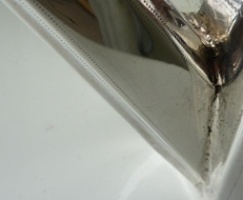 |
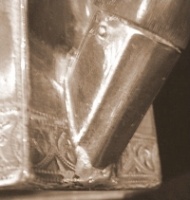 |
Possible strengthening of foot
|
Reattachment or repair of spout (small voids)
|
Solder reinforcement of bracket
|
On the hand, significant repairs or
enhancements like replacement of handle supports, silver
reinforcement patches to the lid or spout, or added chasing or
out of period engraving significantly distract from a piece's
originality and hence its value.
The originality of the handle and finial can be viewed as either
less or equally important. It seems to depend on whether a
collector is concerned more about the actual crafting of the
piece by the silversmith or the overall statement of the final
product. In the former case, the handle and final are viewed
more as necessary additions, which might well have needed
replacement over time (actually the silver pins holding the
handle in place were usually designed for its removal, as was
the threaded post and wing-nut attachment of the finial.) To
support this view, it appears that a number of handles and
finials were replaced (actually one of the reported "authorized"
tasks of early American silversmiths was repairing handles on
imported silver coffeepots and teapots.) However as we describe
in more detail in another post, we tend to ascribe to the later
view, in that we believe the handle and finial are an integral
part of the overall design. Therefore the originality of the
handle and finial is a significant evaluation consideration for
us.
Joanne and Emmett Eldred
- 2012 -
|
|
|

